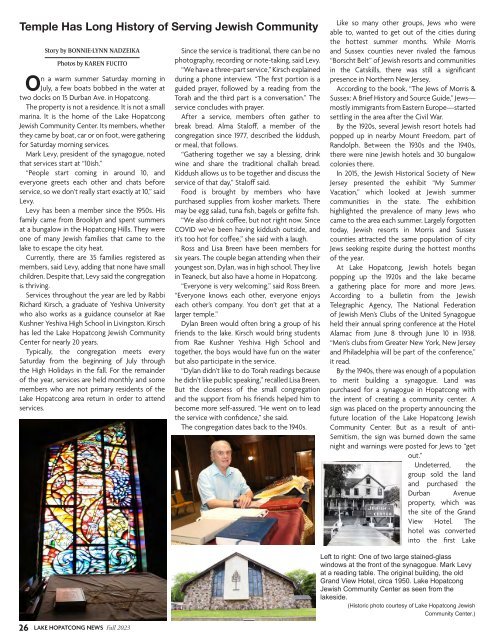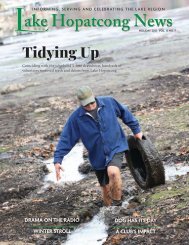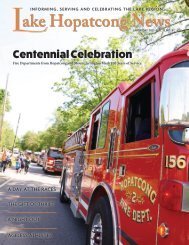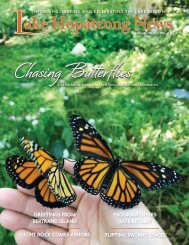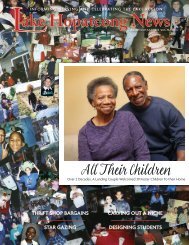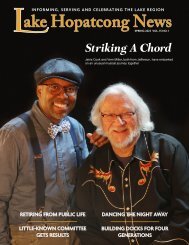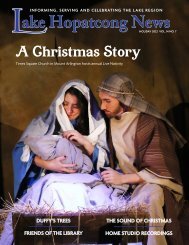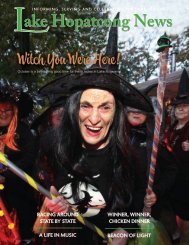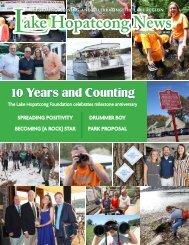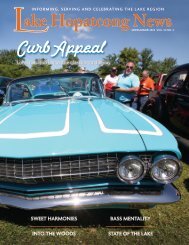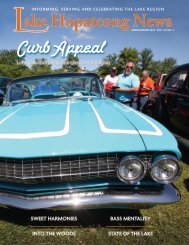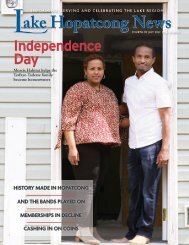2023 Fall Issue
You also want an ePaper? Increase the reach of your titles
YUMPU automatically turns print PDFs into web optimized ePapers that Google loves.
Temple Has Long History of Serving Jewish Community<br />
Story by BONNIE-LYNN NADZEIKA<br />
Photos by KAREN FUCITO<br />
On a warm summer Saturday morning in<br />
July, a few boats bobbed in the water at<br />
two docks on 15 Durban Ave. in Hopatcong.<br />
The property is not a residence. It is not a small<br />
marina. It is the home of the Lake Hopatcong<br />
Jewish Community Center. Its members, whether<br />
they came by boat, car or on foot, were gathering<br />
for Saturday morning services.<br />
Mark Levy, president of the synagogue, noted<br />
that services start at “10ish.”<br />
“People start coming in around 10, and<br />
everyone greets each other and chats before<br />
service, so we don’t really start exactly at 10,” said<br />
Levy.<br />
Levy has been a member since the 1950s. His<br />
family came from Brooklyn and spent summers<br />
at a bungalow in the Hopatcong Hills. They were<br />
one of many Jewish families that came to the<br />
lake to escape the city heat.<br />
Currently, there are 35 families registered as<br />
members, said Levy, adding that none have small<br />
children. Despite that, Levy said the congregation<br />
is thriving.<br />
Services throughout the year are led by Rabbi<br />
Richard Kirsch, a graduate of Yeshiva University<br />
who also works as a guidance counselor at Rae<br />
Kushner Yeshiva High School in Livingston. Kirsch<br />
has led the Lake Hopatcong Jewish Community<br />
Center for nearly 20 years.<br />
Typically, the congregation meets every<br />
Saturday from the beginning of July through<br />
the High Holidays in the fall. For the remainder<br />
of the year, services are held monthly and some<br />
members who are not primary residents of the<br />
Lake Hopatcong area return in order to attend<br />
services.<br />
Since the service is traditional, there can be no<br />
photography, recording or note-taking, said Levy.<br />
“We have a three-part service,” Kirsch explained<br />
during a phone interview. “The first portion is a<br />
guided prayer, followed by a reading from the<br />
Torah and the third part is a conversation.” The<br />
service concludes with prayer.<br />
After a service, members often gather to<br />
break bread. Alma Staloff, a member of the<br />
congregation since 1977, described the kiddush,<br />
or meal, that follows.<br />
“Gathering together we say a blessing, drink<br />
wine and share the traditional challah bread.<br />
Kiddush allows us to be together and discuss the<br />
service of that day,” Staloff said.<br />
Food is brought by members who have<br />
purchased supplies from kosher markets. There<br />
may be egg salad, tuna fish, bagels or gefilte fish.<br />
“We also drink coffee, but not right now. Since<br />
COVID we’ve been having kiddush outside, and<br />
it’s too hot for coffee,” she said with a laugh.<br />
Ross and Lisa Breen have been members for<br />
six years. The couple began attending when their<br />
youngest son, Dylan, was in high school. They live<br />
in Teaneck, but also have a home in Hopatcong.<br />
“Everyone is very welcoming,” said Ross Breen.<br />
“Everyone knows each other, everyone enjoys<br />
each other’s company. You don’t get that at a<br />
larger temple.”<br />
Dylan Breen would often bring a group of his<br />
friends to the lake. Kirsch would bring students<br />
from Rae Kushner Yeshiva High School and<br />
together, the boys would have fun on the water<br />
but also participate in the service.<br />
“Dylan didn’t like to do Torah readings because<br />
he didn’t like public speaking,” recalled Lisa Breen.<br />
But the closeness of the small congregation<br />
and the support from his friends helped him to<br />
become more self-assured. “He went on to lead<br />
the service with confidence,” she said.<br />
The congregation dates back to the 1940s.<br />
Like so many other groups, Jews who were<br />
able to, wanted to get out of the cities during<br />
the hottest summer months. While Morris<br />
and Sussex counties never rivaled the famous<br />
“Borscht Belt” of Jewish resorts and communities<br />
in the Catskills, there was still a significant<br />
presence in Northern New Jersey.<br />
According to the book, “The Jews of Morris &<br />
Sussex: A Brief History and Source Guide,” Jews—<br />
mostly immigrants from Eastern Europe—started<br />
settling in the area after the Civil War.<br />
By the 1920s, several Jewish resort hotels had<br />
popped up in nearby Mount Freedom, part of<br />
Randolph. Between the 1930s and the 1940s,<br />
there were nine Jewish hotels and 30 bungalow<br />
colonies there.<br />
In 2015, the Jewish Historical Society of New<br />
Jersey presented the exhibit “My Summer<br />
Vacation,” which looked at Jewish summer<br />
communities in the state. The exhibition<br />
highlighted the prevalence of many Jews who<br />
came to the area each summer. Largely forgotten<br />
today, Jewish resorts in Morris and Sussex<br />
counties attracted the same population of city<br />
Jews seeking respite during the hottest months<br />
of the year.<br />
At Lake Hopatcong, Jewish hotels began<br />
popping up the 1920s and the lake became<br />
a gathering place for more and more Jews.<br />
According to a bulletin from the Jewish<br />
Telegraphic Agency, The National Federation<br />
of Jewish Men’s Clubs of the United Synagogue<br />
held their annual spring conference at the Hotel<br />
Alamac from June 8 through June 10 in 1938.<br />
“Men’s clubs from Greater New York, New Jersey<br />
and Philadelphia will be part of the conference,”<br />
it read.<br />
By the 1940s, there was enough of a population<br />
to merit building a synagogue. Land was<br />
purchased for a synagogue in Hopatcong with<br />
the intent of creating a community center. A<br />
sign was placed on the property announcing the<br />
future location of the Lake Hopatcong Jewish<br />
Community Center. But as a result of anti-<br />
Semitism, the sign was burned down the same<br />
night and warnings were posted for Jews to “get<br />
out.”<br />
Undeterred, the<br />
group sold the land<br />
and purchased the<br />
Durban Avenue<br />
property, which was<br />
the site of the Grand<br />
View Hotel. The<br />
hotel was converted<br />
into the first Lake<br />
26<br />
LAKE HOPATCONG NEWS <strong>Fall</strong> <strong>2023</strong><br />
Left to right: One of two large stained-glass<br />
windows at the front of the synagogue. Mark Levy<br />
at a reading table. The original building, the old<br />
Grand View Hotel, circa 1950. Lake Hopatcong<br />
Jewish Community Center as seen from the<br />
lakeside.<br />
(Historic photo courtesy of Lake Hopatcong Jewish<br />
Community Center.)


